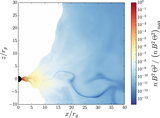Blazar Variability from Turbulence in Jets Launched by Magnetically Arrested Accretion Flows
Abstract
Blazars show variability on timescales ranging from minutes to years, the former being comparable to and in some cases even shorter than the light-crossing time of the central black hole. The observed γ-ray light curves can be described by a power-law power density spectrum (PDS), with a similar index for both BL Lacs and flat-spectrum radio quasars. We show that this variability can be produced by turbulence in relativistic jets launched by magnetically arrested accretion flows (MADs). We perform radiative transport calculations on the turbulent, highly magnetized jet launching region of a MAD with a rapidly rotating supermassive black hole. The resulting synchrotron and synchrotron self-Compton emission, originating from close to the black hole horizon, is highly variable. This variability is characterized by PDS, which is remarkably similar to the observed power-law spectrum at frequencies less than a few per day. Furthermore, turbulence in the jet launching region naturally produces fluctuations in the plasma on scales much smaller than the horizon radius. We speculate that similar turbulent processes, operating in the jet at large radii (and therefore a high bulk Lorentz factor), are responsible for blazar variability over many decades in frequency, including on minute timescales.
- Publication:
-
The Astrophysical Journal
- Pub Date:
- July 2017
- DOI:
- 10.3847/1538-4357/aa7339
- arXiv:
- arXiv:1704.05882
- Bibcode:
- 2017ApJ...843...81O
- Keywords:
-
- accretion;
- accretion disks;
- black hole physics;
- galaxies: jets;
- gamma rays: galaxies;
- radiative transfer;
- turbulence;
- Astrophysics - High Energy Astrophysical Phenomena
- E-Print:
- 8 pages, 5 figures, removed section from appendix, references added, accepted for publication in ApJ
